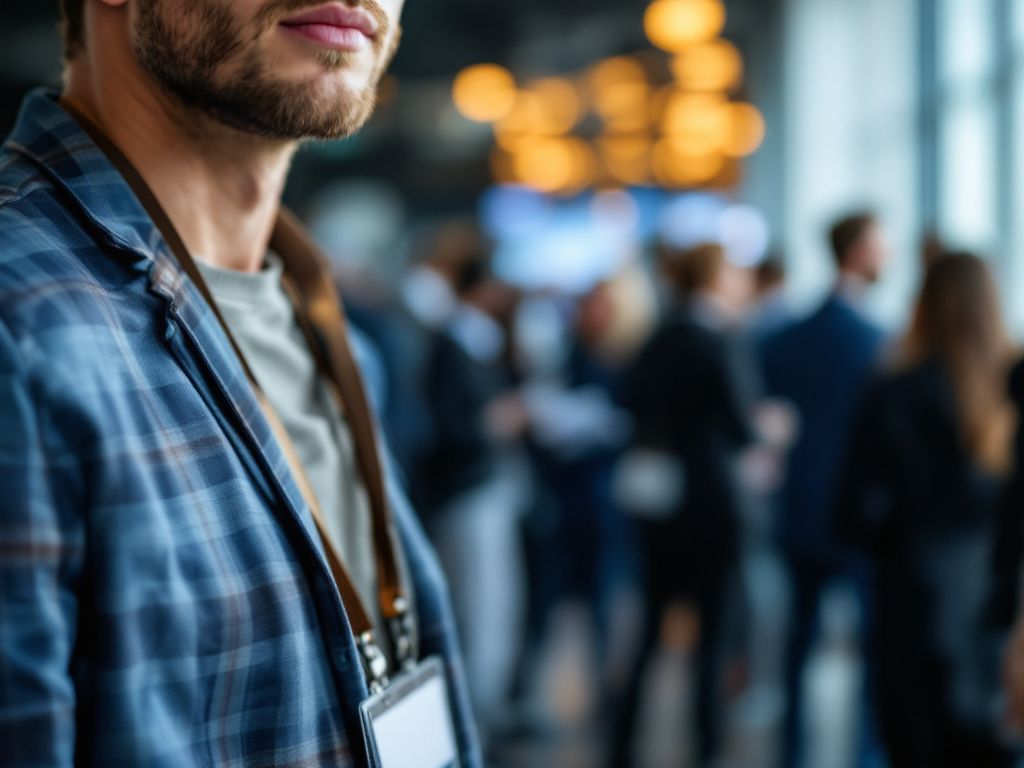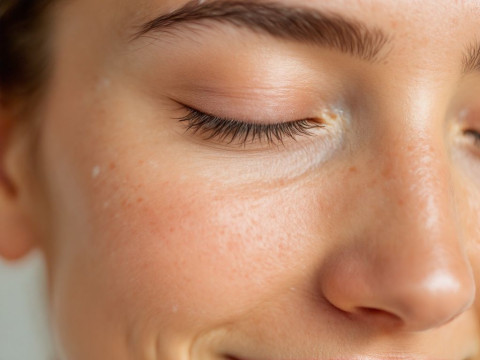Ever been to a conference where you met someone fascinating, only to forget their name because you couldn’t quite make out the photo on their badge? Frustrating, right? It’s something that makes us question not just our memory but also the practicality of those little conference lifesavers—our badge photos.
Your conference badge is more than just a pass—it’s often your opening statement. It’s a medium for introducing yourself before you even say a word. So, how do you make sure yours tells the story you want? Let’s chat about it.
Why Conference Badge Photos Matter
The truth is, no one wants to play the guessing game at a networking event. Your badge is like the visual first impression in this bustling world of business interactions. A clear, professional, yet personable photo can set the stage for meaningful connections. And like it or not, these photos bridge the gap between those in the know and those still guessing who you might be.
Creating a Lasting Impression
Trust me, a good photo isn’t just about looking good; it’s about being memorable. Attendees will likely encounter dozens, if not hundreds, of people. That tiny image on your badge can say a lot about your professional persona—or not. Picture this: someone wants to follow up post-event, but all they remember is your smile. Your badge photo can act like a visual business card, sparking enough recall to make a second conversation convenient.
The Key to a Photo Ready Conference Badge
First things first, it’s about preparation. Getting ‘photo ready’ isn’t just the act of snapping a great shot; it’s about preparation and intention behind the image you want to project.
Consider the Context
Adjust your image to the nature of the event. Is it a formal corporate conference, or is it a more relaxed industry gathering? Let your selfie reflect your audience. Handy tip: for business events requiring a professional touch, a clean, simple background that doesn’t distract from your face is best.

Lighting is Everything
It can make or break your shot. Natural light works wonders—it’s softer, more flattering, and doesn’t cast odd shadows like some artificial lights. If snapping a photo indoors, stand facing a window for the best results. After all, you want to be remembered for how well you navigated an idea, not the poor lighting that played tricks with your features.
Dress to Impress
There’s a fine line between too casual and too overdone. Wear colors that complement your skin tone and don’t clash with the badge design. Subdued, solid colors usually work well. This consistency helps your face become the focal point, making it an easy point of reference for attendees looking at your badge.
Finding the Right Angle
Ah, the elusive best angle! It’s less mystery and more about feeling comfortable. Avoid extreme angles that distort your features. Directly facing the camera with a slight tilt of your chin can produce a natural, inviting look.
Step-by-Step: Capturing the Perfect Badge Photo
Here’s a breakdown of the steps you’ll want to follow:
- Check the Requirements: Make sure to understand any specific guidelines provided by the conference organizers. Some events have dimensions or background color stipulations—get these right to avoid last-minute hiccups.
- Prepare the Setting: As mentioned, opt for natural light. Find a decluttered background—neutral shades work best. A plain wall or a quiet park does wonders.
- Dress Meaningfully: Choose colors that suit the event but also resonate with your personal brand. A neat shirt or blouse that enhances your skin tone will go a long way in crafting approachability.
- Set the Camera: Most phones now have excellent cameras. Use the back camera if you can; it usually has higher quality than the front. Stabilize the device—or better yet, use a tripod—to avoid blurring.
- 5. **Strike the Pose: Test a few angles. Maintain a welcoming expression—smile if it feels natural, but a soft, confident grin works wonders too.
- 6. **Take Lots: Don’t settle on one click. Snap a few, review them, and pick the one where your charisma shines through clearly.
- 7. **Edit Sparingly: It’s alright to touch up photos slightly. Adjust brightness, contrast, and maybe a bit of sharpening if needed, but don’t overdo it to retain authenticity.
Mind the Details and Common Mistakes

Alright, cue the reality check: even with the best-laid plans, things can go awry. Here’s where most people slip up:
Over-editing
Keen to use that new photo app filter? I get it—it’s tempting. Yet, it can distort your features to a point where your fellow conference-goers are left wondering if that photo even matches the person! Keep edits minimal to preserve authenticity.
Busy Backgrounds
Trust me, your bathroom shelf isn’t the optimal backdrop for your professional debut. Stick with clear, simple backgrounds that won’t detract from focusing on you.
Incorrect Dimensions or Resolution
It happens—a fantastic shot rendered unusable because of improper sizing. Keep aware of resolution requirements to avoid blurry images that do little to aid professional recognition.
Making Sure Your Badge Photo Works for You

In wrapping this up, let’s talk return on investment. Once you’ve set the stage with an effective badge photo, it pays off to make it work across multiple fronts.
Sync with Your Digital Presence
Match your badge photo with your online avatars. Whether you’re on LinkedIn, Twitter, or other networking platforms, keeping the visual continuity leads to better recognition in offline and online spaces. A unified visual method lets your contacts connect dots seamlessly across your digital realms.
Leverage for Business
Your badge signals more than just identification; it’s a potential sales ally. A friendly, intentional photo inherently sets you apart from the crowd, portraying you as approachable. In massive events, this first silent introduction paves the way for new opportunities.
Connecting the Dots Post-Conference
Once the dust of the conference settles, your photo aids in cementing those initial face-to-face connections. Follow-up communications are more effective when acquaintances can link your name to your face, strengthening the memory of conversations had.
Key Takeaways
By now, you probably see that conference badge photos are more than a mere formality—they’re strategic tools in the client-to-client and peer-to-peer engagement web. Here’s a quick recap of things to mind:
- Understand the context of the event to adjust formality levels.
- Optimize lighting and background to emphasize your face.
- Choose clothing that aligns with both the professional setting and your style.
- Use minimal editing to preserve authenticity.
- Synchronize this image with your broader professional profiles.
Your badge is more than a credential—it’s a piece of your professional identity. An image clear in intention, lighting, and presentation lets you stand assured, even before words come into the mix.
Armed with the right photo, step confidently into that bustling networking arena. That tiny badge might just be your biggest asset in making a memorable first impression.
Frequently Asked Questions
How far in advance should I start preparing my skin for an event?
It is recommended to start preparing your skin at least 6 weeks to several months before the event. This allows time for skincare routines, dietary changes, and any necessary treatments to take effect. For more intensive treatments like laser or chemical peels, planning 2-3 months in advance is often advised[3][4][5).
What are the key elements to focus on for event skincare?
The key elements include prioritizing hydration by drinking plenty of water, getting quality sleep to aid in skin repair and regeneration, nourishing your skin with a diet rich in antioxidants and healthy fats, engaging in regular exercise to improve circulation, managing stress through techniques like meditation or journaling, and avoiding inflammatory foods close to the event. Additionally, practices like facial massage and proper skincare routines are crucial[1].
What types of treatments are recommended close to an event?
For the week leading up to the event, focus on treatments that hydrate and refresh the skin, such as facials, HydraFacials, and dermaplaning. These treatments help slough off dead skin, intensely hydrate, and prepare the skin for makeup application without the risk of downtime or side effects[3][4][5].
How can I ensure my makeup looks flawless for the event?
To ensure flawless makeup, make sure your skin is well-prepared through a holistic skincare approach. Use a nourishing serum and primer, and consider treatments like dermaplaning to smooth the skin surface. This helps makeup apply more evenly and enhances its performance[1][4].
References










